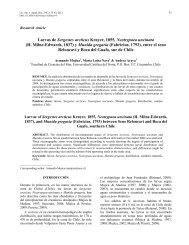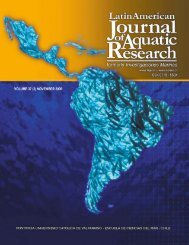Portada LAJAR.psd - Latin American Journal of Aquatic Research
Portada LAJAR.psd - Latin American Journal of Aquatic Research
Portada LAJAR.psd - Latin American Journal of Aquatic Research
You also want an ePaper? Increase the reach of your titles
YUMPU automatically turns print PDFs into web optimized ePapers that Google loves.
448<br />
Lat. Am. J. Aquat. Res.<br />
Palabras clave: ciclo diario, dinámica mareal, patrones específicos, depredadores, cardúmenes, sur de Brasil.<br />
________________________<br />
Corresponding author: Fabiana C. Félix Hackradt (felixhackradtfc@gmail.com)<br />
INTRODUCTION<br />
Studies <strong>of</strong> fish assemblages in surf zones can provide<br />
not only information <strong>of</strong> the temporal structure <strong>of</strong><br />
populations on both seasonal and diel basis, but also<br />
<strong>of</strong> the life-history phases that occupy the surf zone<br />
habitats. However, in such dynamic environment it is<br />
difficult to compare studies due to possible seasonal<br />
and diel differences in sampling effort, or gear<br />
susceptibility <strong>of</strong> different life stages (Ross, 1983). In<br />
general, seasonal changes in surf zone ichthy<strong>of</strong>aunas<br />
are characterised by low abundance and diversity<br />
during winter and the opposite pattern during warmer<br />
months (Fox & Mack, 1968; Naughton & Saloman,<br />
1978; Modde & Ross, 1981; Allen, 1982; Ross, 1983;<br />
Lasiak, 1984b). These trends suggest that surf zone<br />
habitats may be briefly used by fish moving along the<br />
coast through passes into more protected waters, or by<br />
species that remain in the outer beach system for<br />
longer periods (Ross, 1983).<br />
Short-term changes in abundance occur mainly due<br />
to the tidal cycle, moon phase, and alternation <strong>of</strong> night<br />
and day (Oliveira-Neto et al., 2004). Many studies<br />
have found different patterns <strong>of</strong> fish habitat use, with<br />
greater daytime catches (Allen, 1982; Nash & Santos,<br />
1998; Rooker & Dennis, 1991) and higher number <strong>of</strong><br />
species and diversity during the night (Livingston,<br />
1976; Nash & Santos, 1998; Lin & Shao, 1999). Nash<br />
(1986) and Gibson et al. (1996) concluded that<br />
community structure variation is strongly influenced<br />
by the dominant species peculiarities and as a<br />
consequence, failed to find a clear periodic pattern.<br />
In this context, the present work aims to investigate<br />
the diel variability <strong>of</strong> the structure <strong>of</strong> a surf-zone fish<br />
community on a sheltered beach in southern Brazil.<br />
The study was carried out over a one-year period and<br />
emphasized the description <strong>of</strong> the patterns <strong>of</strong> variation<br />
<strong>of</strong> the most abundant species.<br />
MATERIAL AND METHODS<br />
Study site<br />
Pontal do Sul is a sheltered sandy beach that is<br />
influenced by Ilha do Mel (island), which is located at<br />
Paranaguá estuary mouth. In addition, submerged<br />
channels created by ebb and flood tides reduce the<br />
incidental wave energy (Fig. 1). The beach is<br />
microtidal with two ebb tides per day. According to<br />
Godefroid et al. (1997) who investigated surf zone<br />
fishes on the same beach using different fishing gears,<br />
this beach is classified as dissipative due to the fine to<br />
medium sediment grain sizes, flat slope and medium<br />
wave heights. The weather is classified as subtropical<br />
humid with a warm and wet summer (December to<br />
February) and an undefined dry season (Maack, 1981),<br />
usually considered winter (June to August).<br />
Furthermore, spring and autumn months are defined as<br />
from September to November and March to May,<br />
respectively.<br />
Sampling<br />
The surf zone <strong>of</strong> Pontal beach, Paraná, Brazil, was<br />
extensively studied from August 2004 to June 2005.<br />
Bimonthly over a period <strong>of</strong> six months, three seine<br />
hauls were performed at 3 h intervals for 24 h on each<br />
sampling date. Due to weather conditions, April<br />
samples were postponed to the following month, May.<br />
Sampling occurred during spring tides at 8, 11, 14, 17,<br />
20, 23, 2 and 5 h, in order to coincide with high, midfalling,<br />
low and mid-rising tides, but this pattern could<br />
not always be followed. According to the day length,<br />
four samples were collected in daylight and other four<br />
at night-time during the entire studied period. All<br />
these samplings were considered replicates.<br />
All hauls covered a 30 m extension and were<br />
separated by 5 m to minimize the influence on the<br />
subsequent haul. A 15 m x 2.6 m seine net, with 2 m 2<br />
bag and 0.5 cm 2 mesh throughout was used to collect<br />
the ichthy<strong>of</strong>auna. The net was laid parallel to the shore<br />
at approximately 1.5 m depth <strong>of</strong> water between 10 and<br />
30 m <strong>of</strong>fshore, and was hauled by two people, one on<br />
each end <strong>of</strong> the net, following the direction <strong>of</strong> the<br />
current.<br />
All fish collected were identified to species level<br />
following Fischer (1978), Figueiredo & Menezes<br />
(1978, 1980, 2000), Menezes & Figueiredo (1980,<br />
1985) and Barletta & Corrêa (1992). These fishes<br />
were then weighted (g) and measured to the nearest 1<br />
mm (total length and standard length), except when<br />
samples were very large. In these occasions,<br />
measurements were restricted to a sub-sample <strong>of</strong> 30<br />
individuals per species. The excess was weighted,<br />
counted and incorporated as weight and number<br />
counts. In addition, sex (male, female or not<br />
identified) and maturity stages were documented for<br />
the sub-sample through direct observation, according







